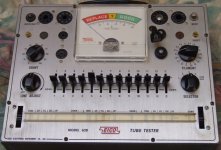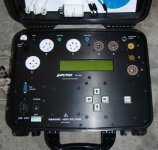Could be that a CV4004 is a touch different than a 12ax7 too. I seem to recall them, M8137 or whatever, being a touch different.
Hi riffer3,
The cheaper testers only check emission. That figure is useless. If those testers show a tube to be bad, it's complete toast. If it shows good, could very easily be bad. So why bother?
Up here you can more easily find the Stark 9-66. That is an excellent tester and made under license from Hickok. I use one of these. These have gone up greatly in value as of late.
The best test is to install the tube in a known good working circuit.
-Chris
No.Are there any testers under $200 or so that can adequately test 6SN7, 6AS7, 6DJ8, AT7 etc?
The cheaper testers only check emission. That figure is useless. If those testers show a tube to be bad, it's complete toast. If it shows good, could very easily be bad. So why bother?
Up here you can more easily find the Stark 9-66. That is an excellent tester and made under license from Hickok. I use one of these. These have gone up greatly in value as of late.
The best test is to install the tube in a known good working circuit.
-Chris
anatech said:Hi riffer3,
No.
The cheaper testers only check emission. That figure is useless. If those testers show a tube to be bad, it's complete toast. If it shows good, could very easily be bad. So why bother?
Up here you can more easily find the Stark 9-66. That is an excellent tester and made under license from Hickok. I use one of these. These have gone up greatly in value as of late.
The best test is to install the tube in a known good working circuit.
-Chris
I have an EICO 667, paid $120 on ebay. It's a dynamic mutual conductance. Very nice to use : metal case, can be switch to test "unknown tubes".
Look at this URL very instructive : http://www.tone-lizard.com/Tube_Testers.html
I got one but i alot of my tubes like 211's and 304tl's can't be tested due to odvious limitations.
Hi all,
Does anyone have test data for the Hickok 800? I sometimes run into tubes that are not on my testers data sheet.
Thanks!
Does anyone have test data for the Hickok 800? I sometimes run into tubes that are not on my testers data sheet.
Thanks!

I picked a Western Electric KS-5727-L1 which looks to really be a Hickok 536. I'm sure it needs calibrated but can't verify if its done the same was as a Hickok (no manual). Anyone care to comment?
http://bellsouthpwp.net/p/a/padgett46/5727_l1.jpg
http://bellsouthpwp.net/p/a/padgett46/5727_l1.jpg
No, I usually just plug the tube into the circuit and compare with the loadline plot for the given circuit. Or plug a known good tube into the circuit and compare voltage readings to that of the tube in question.
soundbrigade said:I have spotted a tube tester - Precision apparatus 912. Is this something worth buying?
Hi All
While they are not in the league of the Hickoks the Precision 910, 912, 920, etc series are very useful... They use a dynamic test circuit that supplies AC to the control grid, which means they aren't just emission(diode) testers, all elements are utilized in testing... The Eico 666/667 and Jackson 648 use similar circuits...
Main draw back is, the last ones were produced in '47 so only a few late ones have a 9 pin socket(very early versions do not have a miniature 7 pin)... Precision supplied a 9 pin to octal adapter that works just fine, maybe 25% of the ones I've seen on ebay include it... If you want to test Compactron,s Nuvistors etc, that requires another adapter that must be used in the 9pin socket(or adapter)... Unfortunately those can be a bit hard to find often bringing as much if not more than the tester it's self...
Tom
Hi soundbrigade,
Define the tubes that you need to test. Some of the newer tube testers might fit the bill. Alas, no good tube testers are cheap.
-Chris
Sure. Most have similar pinouts. The only real problem is figuring out the other settings. You are probably further ahead to get the one that does what you need.Would it be possible to make adapters for 9-pin and 7-pin sockets?
Define the tubes that you need to test. Some of the newer tube testers might fit the bill. Alas, no good tube testers are cheap.
-Chris
soundbrigade said:Would it be possible to make adapters for 9-pin and 7-pin sockets?
No problem, the 9 pin connections are pin for pin to the octal socket with the 9th connecting to the plate cap(Add a top cap to the side of the octal base)...
There's plenty of setup info here...
http://www.geocities.com/precision_testers@sbcglobal.net/index.html
Maybe without a 9 pin socket you can get a deal...
Tom
I have an AVO 163, but if someone have a spare thumbwheel section, I'd be interested......just one single selector, - or one extra for spare......
I have a SICO emission tester... Not sure how useful, as it has
"passed", just barely, every tube I seem to throw at it... Cept
one with an open filament... I still have one or two with white
getters I could probably expect to fail, but I'm not sure I would
want to subject the meter to that kind of torture test.
My book and scroll lack many common tubes, such as 6DJ8/6922.
Its always a guessing game what reading for these is "normal".
------------------------------------------------------------------------
Anyways, my Labview certification training starts in September.
But I been screwing around blindly with ver8.5 on my own.
It would be dirt simple to make a virtual tube tester in Labview.
Biggest trouble right now is lack of a GPIB interface card. Some
of our scopes and function generators can talk to Labview by
existing Ethernet or USB. But I want to abuse our HP/Agilent
power supplies and Kiethley current sourcemeters. Those all
seem to require the GPIB bus, which I don't yet have. And
probably won't be getting one till after I am "trained".
None source higher than 63V, I need to figure how to add onto
that voltage without screwing current readings or any huge risk
of blowing up expensive test equipment... I would like to graph
curves out to at least 250V.
"passed", just barely, every tube I seem to throw at it... Cept
one with an open filament... I still have one or two with white
getters I could probably expect to fail, but I'm not sure I would
want to subject the meter to that kind of torture test.
My book and scroll lack many common tubes, such as 6DJ8/6922.
Its always a guessing game what reading for these is "normal".
------------------------------------------------------------------------
Anyways, my Labview certification training starts in September.
But I been screwing around blindly with ver8.5 on my own.
It would be dirt simple to make a virtual tube tester in Labview.
Biggest trouble right now is lack of a GPIB interface card. Some
of our scopes and function generators can talk to Labview by
existing Ethernet or USB. But I want to abuse our HP/Agilent
power supplies and Kiethley current sourcemeters. Those all
seem to require the GPIB bus, which I don't yet have. And
probably won't be getting one till after I am "trained".
None source higher than 63V, I need to figure how to add onto
that voltage without screwing current readings or any huge risk
of blowing up expensive test equipment... I would like to graph
curves out to at least 250V.
- Status
- Not open for further replies.
- Home
- Design & Build
- Equipment & Tools
- Vacuum tube tester, do you own one?


